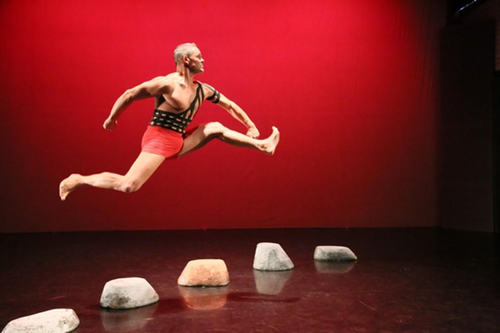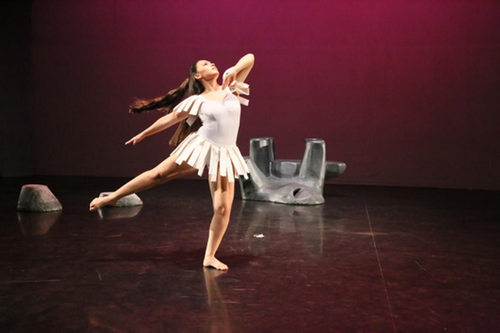
Fri 11/10-Sat 11/11
Thu 11/16-Sat 11/18
Every November the CWRU Department of Dance produces a concert featuring faculty and guest artists. This year three major 20th-century artists are represented in Cave of the Heart, Martha Graham’s treatment of the myth of Jason and Medea with a set by Isamu Noguchi and a commissioned score by Samuel Barber. We spoke with professor and artistic director Gary Galbraith on the phone.
CoolCleveland: Transporting the Noguchi set pieces to Cleveland must have involved considerable care in packing. After all, they’re works of art.
Gary Galbraith: Yep. It all goes into big crates. We were laughing because the “Spider Dress,” the wire sculpture that Graham climbs into as Medea, weighs maybe 10 pounds, but once it’s packed for shipment, it’s 200 or 300 pounds.
I called up Mark Cole at Cleveland Museum of Art to see if he was interested in seeing some Noguchis. He was over here looking at them and I said, “Go ahead and touch them.” He said, “I don’t have my curator’s gloves” and I said, “Go ahead. The dancers stand on them.”
CC: How did you arrange to perform Cave? Did you apply to the Graham company for permission? [We were expecting to hear about a process similar to Cleveland Ballet’s collaboration with the Balanchine Trust for Serenade or Verb’s collaboration with the Arpino Foundation for Celebration.]
GG: Graham Resources was set up after Graham died and it is not unlike the Balanchine Trust. Our situation is a bit unusual, though, in that I’ve been setting Graham works for a while and I danced the role of Jason in Cave for some time. So, it was not at all difficult to get permission to produce Cave. Here it’s been more the logistics. Case had the set shipped from Jacob’s Pillow after the Graham company performed it there last summer. The costumes were not available to us so Karen [Karen Potter, Professor and Department Chair] has led reconstruction.
Shipping the set was costly. Janice Herring [of the Graham company] says that touring the Cave set is too expensive and so the Graham company will not be performing Cave outside of New York for the foreseeable future.
CC: So this is a rare opportunity to see Cave performed outside of New York. Can you comment on the relationship between Graham’s Cave and Euripides’ play Medea?
GG: I connected with our colleagues from the Department of Classics. They talked about the myth of Jason and Medea and how Euripides takes a particular point of view that focuses on the woman’s motivations and actions. Interestingly, Graham takes this further. She is looking at the primary response from the woman’s point of view and she makes the anti-heroine, Medea, the winner.
CC: You mentioned Jason’s character arc earlier. Can you enlarge upon that?
GG: In many of Graham’s ballets, the male character is much the same throughout. In Appalachian Spring, for instance, the Husbandman’s character has an evenness and it’s Martha in the role of the Bride who changes. But in Cave, Medea stays the same and it is Jason who is taken down in the course of the drama. Early in the ballet, Jason stands on a set piece three feet above the stage but it’s all downhill for him from there.

Later we spoke in person with Richard Oaxaca, Visiting Assistant Professor, who performs the role of Jason.
CC: How does Jason’s demeanor change in the course of the dance?
Richard Oaxaca: When Jason first enters, he is very confident, very sure of himself. Stoic. Strong. Like this. [He demonstrates Jason’s entrance: big steps with flexed feet and a rigidly upright torso. The effect is arrogant and offputting. Jason is not the good guy in Graham’s dance.] He looks at nothing but the princess because he knows that she is his ticket. He doesn’t look at Medea at all. At one point Medea grabs on to me and I just push her away.
[CC: Euripides paints Jason as a consummate cad, but Graham does the same without a word.]
RO: There’s a point in Cave where Jason and the Princess are the top of the entire stage. They are at a high point, both in their lives and on the stage and Medea’s below them.
CC: But it’s all downhill from there, right?
RO: Yeah. That’s when Medea gets pissed off and basically sets the princess on fire and, as I said, at the end of the dance, the Princess and I are at the bottom and Medea is on top.
[CC: In Euripides’ play, Medea uses her skills as a sorceress and smears a deadly poison on a beautiful cloak and crown. When the Princess impulsively puts them on, she’s engulfed in deadly chemical flames.]
RO: Many of the female roles in the Graham repertoire are like that, full throttle. Martha was head of the company and when she choreographed she was who she was. Meanwhile, Jason is one male role that Graham paid a lot of attention to. Erick Hawkins probably had a lot to do with that. He was the first man in Graham’s company and the first to dance Jason. Erick was a good dancer and a choreographer and they probably took advantage of that.
CC: [During our conversation, Oaxaca has been polishing the wire structure of Medea’s “Spider Dress.” What is that product you’re using?
RO: It’s Brasso. This prop is pretty old but if I polish it, even a little bit, it looks really gorgeous in the light. So, every few days, I polish it.

Later we spoke with Karen Potter, first about the Cave costumes and then about her new aerial dance.
Karen Potter: So, I’m reconstructing the costumes for Cave of the Heart. It’s a privileg, Victor, but it is daunting. I have been putting in seven days a week for the past six weeks of the semester. The costumes were originally designed by Martha Graham with input, we believe, from Isamu Noguchi and Erick Hawkins. They are classic Graham costumes, very specific, very detailed. Gary and I went to the Graham Studio in New York, pulled out the costumes, took photographs, took notes, and measured. From that information I made patterns. I made some mistakes in fabric choices so I had to redo a couple of costumes. Mostly the Princess. But I finally got the right fabric and now I’m pleased with that costume. Gary has actually made the costume for Jason. Thank goodness because that one is also very difficult. And since Gary danced Jason when he was a principal in the company, he knew what the costume should feel like. I have just finished the Medea dress today. A few details remain. I have to sew all of the green and gold trim onto the dress by hand. It’s been hard, but I’m looking forward to opening night.
CC: This is not your first rodeo as far as costumes go.
KP: I’ve done a lot of costumes. For instance I reconstructed a Classic Kite Tails dress without a pattern.
CC: Yes, I saw your Classic Kite Tails here at Mather as well as the Hawkins company’s Classic Kite Tails in Erick’s studio. Those are very unconventional costumes that must move just so. But you were in Erick’s company for quite a while and you assisted him in costume design and construction.
KP: I made costumes for Erick’s Plains Daybreak. Parson Weems and the Cherry Tree. Early Floating.
CC: Tell us about your premiere.
KP: Sure. So I’ve created an aerial dance that I started last spring while I was on sabbatical. I have never done aerial dance in my life. So I went to California to visit one of my very first students ever, Cherie Carson. She has her own studio in Berkeley and she has a dance company, UpSwing Aerial Dance Company. I connected with her on Facebook and said, “Oh, I’m so happy to know that you do aerial dance and I’d love to come to your studio. After that visit in Berkeley, I came back here and started working with Richard [Oaxaca] who has background in aerial dance and circus. It’s an aerial duet on silks titled Into the Wind. The dancers take tons of fabric and swirl it around and Brad Petot, our lighting designer, has done wonderful lighting for it.
Also on the concert, In Another Place and Time, Gary Galbraith’s dance using LIDAR technology to fill the stage with light and color. And also, NYC-based Janice Rosario’s Brink.
Performances are November 10 & 11, 16-18 at 7:30pm, and November 12 at 2:30pm. Ticket reservations can be made by calling 216-368-5246 or online at case.edu/artsci/dance/ticket-reservations.
[Written by Elsa Johnson and Victor Lucas]